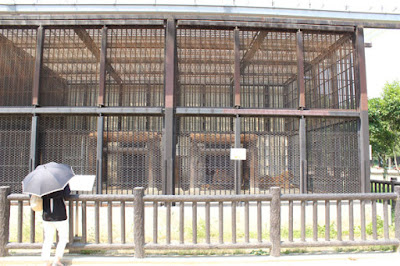Himeji
City Zoo, located in Hyogo Prefecture , sits at the base of historic Himeji Castle Himeji
Castle Himeji Castle
Old Style Exhibits:
Concrete and Cages
Upon entering the zoo, one of
the first exhibits the visitor will see is the Chilean Flamingoes (Phoenicopterus chilensis). This cage-like enclosure looks to be about 18
meters long by about 8 meters wide and about 2.5 meters tall.
In
this enclosure, I counted 30 flamingoes.
Although visitors can get very close to the animals (perhaps too close
from the animal’s perspective), the enclosure fence becomes an unsightly obstacle
when trying to take photographs.
This photo shows the enclosure for the Arabian camel (Camelus dromedarius).
Again, bars get in the way of a good photo.
At the Chimpanzee (Pan trogolodytes) enclosure, acrylic panels were installed in front of the cage/bars, perhaps to protect visitors from having the chimpanzees throw food or feces on them.
Unfortunately, the reflective properties of the acrylic panels on this very bright summer day made it so difficult to see the chimpanzees inside that I couldn’t even see how many animals there were. I also imagine that the panels might also prevent fresh breezes from reaching the animals inside.
Ring-tailed Lemur (Lemur catta) enclosure.
The
row of cages below housed small mammals.
Japanese
badger (Meles meles anakuma)
enclosure.
This
badger had a large bald patch on its back, perhaps from plucking its own fur.
Ezo
Brown Bear (Ursus arctos yesoensis)
enclosure
The
two large brown bears were hard to see behind the bars and fence. In the bright summer sunlight, they resembled
two large shadows.
Lion
(Panthera leo) enclosure
Giraffe
(Giraffa camelopardalis reticulata)
enclosure
Giraffe
indoor enclosure
Magellanic
penguins (Spheniscus magellanicus)
enclosure
The Asian
Elephant (Elephas maximus) enclosure
appeared to be a concrete platform about 20 meters wide by about 20 meters
long. The platform featured a concrete
perimeter surrounding what looked like a dirt square center. The resident
elephant appeared to be reluctant to step out from her house. (Perhaps it was the heat. Perhaps she is shy.)
Two Polar Bears and a
pool
The Polar Bear (Ursus maritimus) enclosure included an
outdoor area about 15 meters long by about 8 meters wide connected to two
smaller sleeping pens. There were two
adult polar bears housed in this exhibit, “Yuki”, a 15-year old female, and “Hokuto”,
a 14-year old male. Many visitors would
consider the area in this enclosure to be small even if there were only one
polar bear. With two polar bears, it appeared
to be very, very small.
The
enclosure featured a pool of water that occupied almost half of the area of the
outdoor enclosure. The pool appeared to
be about 1 to 2 meters deep. During the hour
or so I observed the polar bears, they spent a great deal of time in the
water. Considering the fact that the
temperature that day was announced as exceeding 33 degrees Celsius, and that
the enclosure didn’t have a roof to provide shade, diving into the pool was probably
the only way to escape the heat. When
the polar bears weren’t in the water, they either slept or paced back and forth
along the length of this small enclosure.
The
distance between the polar bears and visitors was only a little more than one
meter.
The
bars and cage construction of the enclosure provides safety, but it also made
it difficult to see the animals and impossible to get a good photograph.
Opportunities for
Animal Encounters
There was a small petting area
featuring domesticated animals: rabbits, ducks, sheep, pigs, and guinea pigs.
This
sign explains that visitors may interact with the animals from 10:30 a.m. to
11:30 a.m. and again from 1:30 p.m. to 2:30 p.m. Zoo staff supervised the petting sessions.
Children Rides and Open
Spaces
This
zoo included a number of rides for small children. Tickets for the rides were 150 yen. Judging by the design and condition, the
machinery of the rides appeared to be decades old.
Overall,
this zoo appears to be visited mostly by local families with small
children. Despite its’ location next to
a World Heritage Site, there didn’t appear to be many visitors from other
countries. And that may be a blessing in
disguise. Visitors from countries that
have large, wide-open zoos would likely disapprove of the relatively small size
of the enclosures and their “cage and concrete” designs.
Himeji
City Zoo has a land area of about 30,000 square meters (3 hectares), small even
when compared to other zoos in Japan Japan
Food and Souvenirs
The
last time I visited this zoo in 2012, there was a small concession that sold
food, drinks and small toys. The
concession stand is no longer there, and in its place are a few coin-operated
vending machines. (Don’t forget to carry
coins. There is no place to get change
for large bills.) For the souvenir
collector, there are no branded zoo souvenirs to be found or bought. The only thing I could take home that had the
zoo name was the admission ticket and the zoo map.
Getting There
Himeji
City Zoo is located immediately next to Himeji Castle Himeji
(Note:
All photos taken in this post were taken during a visit on August 5, 2015. The comments in this post are based on
observations made on that day.
Conditions may have since changed.
Please check it out for yourself!)

































